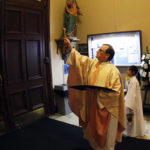By Fr. Joseph Sia
This year I was asked by not one, but two Filipino communities in our diocese to celebrate with them the religious tradition called “Santacruzan.” One community is based in the Quad Cities and the other community is on the western side of the diocese. I gladly accepted their requests because I see the value of celebrating this event not only for them, but also for our church in general.

Catholics celebrate Santacruzan, a Filipino holiday, at St. Mary Parish in Fairfield on May 19.
The word “Santacruzan” is borrowed from the Spanish “Santa Cruz,” which means “Holy Cross” and is a celebration that remembers Queen Helena who, tradition says, on a pilgrimage to Jerusalem in 326 AD found the cross on which Jesus was crucified.
Queen Helena was the mother of Constantine, the emperor of Rome who was influential in promulgating the Edict of Milan. It was this proclamation that declared religious tolerance for Christianity in the Roman Empire. Constantine later converted to Christianity, becoming the first Christian Roman emperor.
The “Santacruzan” is a procession in which Queen Helena is depicted as a woman dressed elegantly as “Reina Elena,” holding a crucifix and accompanied by a little boy who represents her son, Constantine. They are preceded by other women dressed as females who had important roles in Scripture: Queen Esther, Veronica, Mary Magdalene and others.
There are also those who represent the Blessed Virgin Mary in her different titles; for example, ‘Reina del Cielo” (Queen of Heaven), “Rosa Mystica” (Mystical Rose), “Reina de la Paz” (Queen of Peace), “Reina Abogada” (Defender of the Poor) and many more. Little children dressed as angels accompany them as well. The participants pray the rosary as they walk outside the church and follow a carriage transporting a statue of the Blessed Virgin Mary. A Mass is held either before or after the procession.
This tradition is a wonderful celebration of the role of women in our church. It is a reminder that God has bestowed the highest honor of the human race to a woman, the Blessed Virgin Mary. The procession is also a powerful witness to the many women in the Old and New Testament who have given us an example of true love of God. It is also an opportunity for catechism, for not many people are familiar with the story of Queen Helena or of the different titles of the Blessed Virgin Mary as mentioned in her litany.
I would also like to take this opportunity to thank my brother priests who are pastors of the parishes where these processions are held for their hospitality and openness to the Filipino communities in our diocese. Our church is truly catholic, and having these celebrations is a great way to remind us of this mark of the church.











